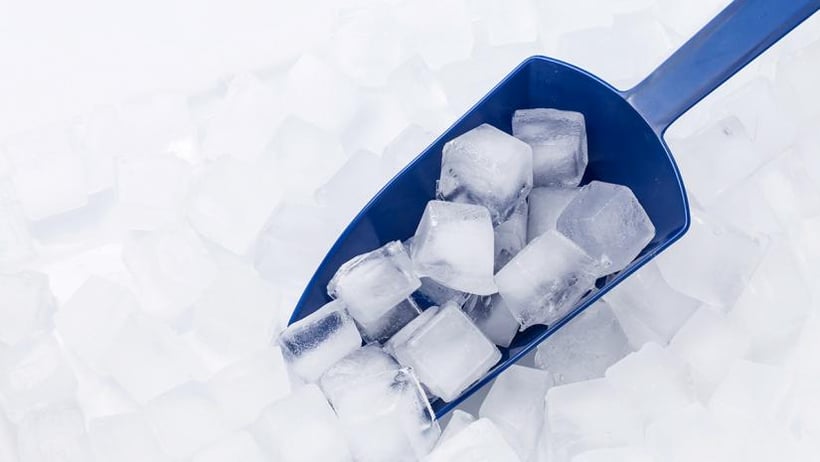
For an individual who works in the food and hospitality industries, food safety is, and should, be top of mind. Food safety and the prevention of food-borne illness are critical to customer safety.
When food and beverage handlers think of potential sources of food-borne illness, they are more likely to think about food items like undercooked meat or spoiled dairy products. Thus, it may be surprising to know that ice can also be a source of food-borne illness.
Food-borne illnesses arise from consuming food that is contaminated with dangerous bacteria, viruses or parasites. The symptoms of food-borne illness can range from mild to severe, and in some cases, leading to hospitalization. Food-borne illness is a serious health concern that must not be taken lightly by anyone that works with food.
Why is ice at risk for contamination?
Ice can become contaminated similarly to food items, and should be treated like a food item when being worked with. Just like food, ice can be contaminated through biological, physical, chemical or cross-contamination. Some examples of contamination include:
- Biological contamination by a Food Handler touching the ice with bare hands
- Cross-contamination from storage in ice machines or the containers it is stored in
- Physical contamination from something falling into the container storing ice (for example, a glass breaks and shards fall into the container)
- Chemical contamination from cleaning chemicals used on ice machines or storage containers
These are just some of the ways that ice can be contaminated.
The rules for safe ice handling
In order to keep ice safe for customers and prevent contamination, follow these rules for safely handling ice:
- Always be sure to wash hands using the correct hand washing method before working with ice in any way.
- Use a utensil when working with ice. Never touch ice with bare hands.
- Be sure that utensils used to serve ice, such as ice scoops, are cleaned and sanitized.
- Store utensils used for ice in an area where they will not become contaminated.
- Use specific containers for storing ice, and make sure they are properly labelled.
- Always clean and sanitize dedicated ice containers before use.
- Store ice containers upside down when not in use in order to prevent contamination.
- Ensure that ice machines are working properly and are clean.
- Inspect ice machines regularly and perform regular maintenance.
- Do not store items near ice machines that could contaminate them (e.g. garbages, recycle bins, dirty dishes).
- Ensure that ice machines are locked so that they cannot be tampered with.
- Do not work with ice if experiencing diarrhea, vomiting, nausea or fever
Food safety training is essential
How to safely handle ice is just one of the food safety measures that all Food Handlers should know. Anyone who works with food should be trained thoroughly in food safety, in order to prevent contamination and food-borne illness incidents. Keeping food safe for consumption is key to running a successful and lawful food business.
The Canadian Institute of Food Safety is a trusted provider of the nationally recognized Food Handler Certification Course.
Frequently Asked Questions
How often should ice machines and utensils be cleaned and sanitized to ensure safety?
Ice machines and utensils should be cleaned and sanitized at least once a month. However, more frequent cleaning may be necessary depending on the usage and environmental conditions, such as high humidity or heavy usage, which can promote mold and bacterial growth. Regular inspections should be performed to ensure cleanliness and safety between full cleanings.
What specific signs should be looked for during the regular inspection of ice machines?
During regular inspections of ice machines, specific signs to look for include:
- Mold or slime build-up inside the machine, particularly around the ice chute and bin.
- Unusual odors emanating from the machine, which could indicate bacterial growth.
- Water leakage or pooling, which may suggest improper drainage or potential contamination
- Inconsistent ice quality, such as cloudiness or unusual shapes, which might indicate dirty water or malfunctioning components.
- Corrosion or wear on machine parts that come into contact with ice.
These signs suggest that cleaning or maintenance may be required.
Are there any regulations or guidelines on the materials that should be used for ice containers to prevent contamination?
Yes, there are regulations and guidelines on the materials used for ice containers to prevent contamination. These materials should be food-grade, non-porous, and easy to clean and sanitize.
Commonly recommended materials include stainless steel and certain types of plastic that are approved for food contact. The materials should be durable and resistant to corrosion or damage that could lead to contamination.
Additionally, they should not impart any odors or flavors to the ice. Regular inspection and maintenance of these containers are also crucial.




